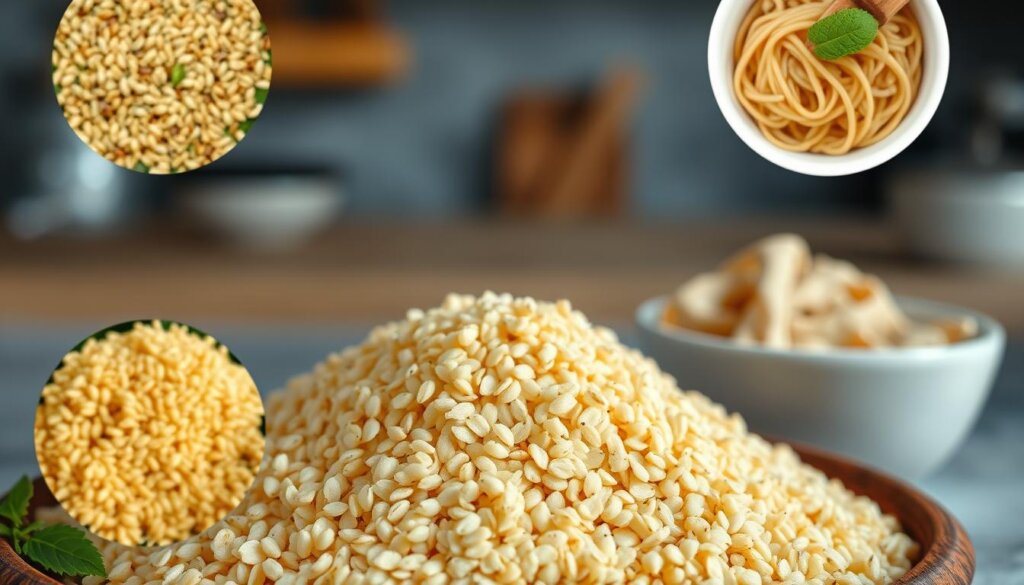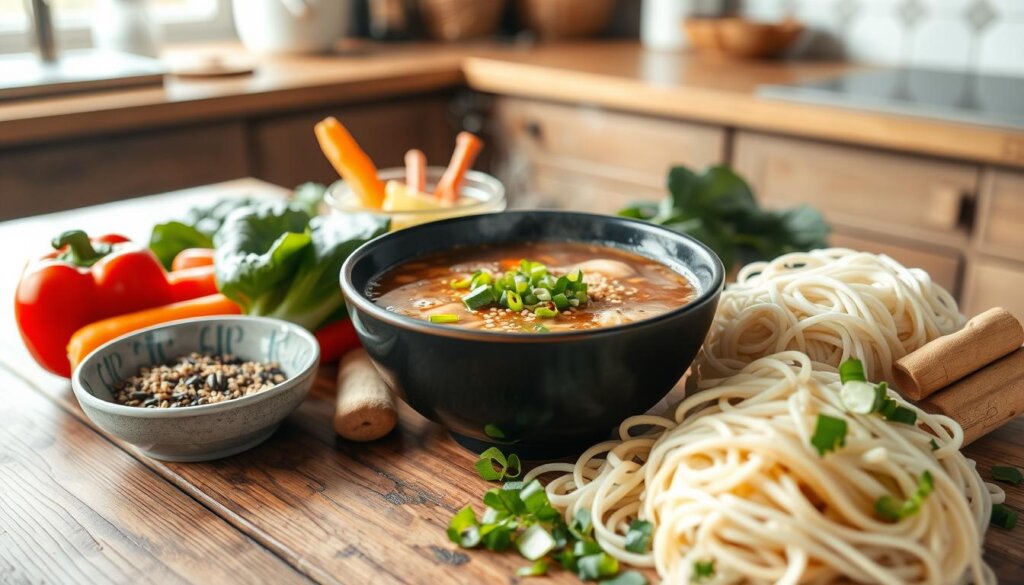Imagine sitting down after a long day, craving the warmth of a bowl of ramen. It’s more than just a meal—it’s a comfort that nourishes both body and soul. But for those with gluten sensitivities, traditional ramen is often off-limits because it’s made from wheat flour.
Whether you have celiac disease, gluten sensitivity, or wheat allergies, you might feel left out. But the good news is that the world of food has changed. Now, you can enjoy gluten-free ramen with ingredients like rice flour, buckwheat, and tapioca starch.
This guide will show you the best gluten-free ramen brands. We’ll also cover the health benefits and cooking tips. You’ll learn how to make healthy ramen alternatives, no matter your dietary needs. For more gluten-free inspiration, check out our guide to Which Grains Have the Least Gluten, explore Safe Gluten-Free Chicken Stir-Fry Recipes, or learn about Gluten-Free Broths to enhance your ramen.
Table of contents
Understanding Gluten and Its Impact on Health
It’s key to understand gluten and its health effects. Gluten is a protein in grains like wheat, barley, and rye. It makes dough elastic, giving ramen noodles their chewy feel. Some people must avoid gluten to stay healthy.
What Is Gluten?
Gluten is crucial for food texture and structure. Foods like pasta and bread often have gluten. This is a problem for those with gluten sensitivity or other disorders. Traditional ramen noodles, made from wheat flour, are not good for them.
Health Conditions Requiring Gluten Avoidance
Some health issues mean you must avoid gluten. Celiac disease causes damage in the small intestine from gluten. People with wheat allergy face severe reactions to gluten. Those with gluten sensitivity might feel bloated or have stomach pain.
About 13% of the world’s population is gluten-sensitive. This shows why gluten-free diets are important. For ramen lovers, try rice noodles, buckwheat noodles, or kelp noodles. They’re tasty and gluten-free.

What Makes Gluten-Free Ramen Special?
Gluten-free ramen is special because of its unique flavors and ingredients. It’s a delicious meal option for those avoiding gluten. Traditional ramen noodles are made from wheat, which isn’t good for gluten-free diets. But, using alternative flours makes it possible to enjoy ramen again.
Ingredients Used in Gluten-Free Ramen Noodles
Gluten-free ramen uses alternative flours for ramen to offer a tasty and healthy meal. Some key ingredients include:
- Rice noodles: These are gluten-free and made from rice flour, offering a light texture.
- Buckwheat noodles: Known as soba, they have a nutty taste and are made from buckwheat flour.
- Shirataki noodles: From konjac yam, they’re almost calorie-free and look translucent.
- Sweet potato glass noodles: Chewy and made from sweet potato starch, they add a unique twist.
- Kelp noodles: Low in calories but rich in minerals, they’re great for a nutritional boost.
- Cellophane noodles: Made from mung bean starch, they’re gluten-free and versatile.

Health Benefits of Choosing Gluten-Free Options
Choosing gluten-free ramen can make your meals better and healthier. Many gluten-free noodles are made from whole grains or nutrient-rich flours. This makes them easier to digest, helping those with gluten sensitivity.
Exploring gluten-free ingredients also brings new flavors and creativity to your cooking. You can make vibrant, healthy meals that meet your dietary needs without losing flavor. By trying different flours, you can enjoy ramen’s comforting taste while staying healthy.
Top Brands for Gluten-Free Ramen
Exploring Gluten-Free Ramen Brands shows a lively market with many tasty options. Here are some top brands that offer delicious, certified gluten-free noodles for fans.
Lotus Foods
Lotus Foods has a range of flavors like Miso, Shoyu, and Tonkotsu in their gluten-free ramen. These noodles are made from non-GMO white rice flour and potato starch. They are quick to cook, just 4-5 minutes, making them great for fast meals.
They come in single-serve packaging, perfect for eating on the go.
King Soba
King Soba is known for its organic gluten-free options. Their ramen is made from buckwheat and brown rice, offering a unique take on traditional flavors. This brand is perfect for those who want healthy, tasty noodles without sacrificing flavor or texture.
Gluten Free Meister
Gluten Free Meister offers ramen noodles that taste just like traditional Japanese soups. They are made in a certified gluten-free facility, making them safe for those with gluten sensitivities. They carefully choose ingredients to bring back beloved flavors while staying gluten-free.
Pamela’s Products
Pamela’s Products has a variety of ramen noodle soups made with rice noodles. These are great for both gluten-free and vegan diets. They ensure all their products are certified gluten-free, appealing to many.
Their ramen seasoning is gluten-free, vegan, and has no MSG. It’s perfect for anyone with specific dietary needs.

How to Prepare Delicious Gluten-Free Ramen
Making ramen at home is rewarding and lets you tailor it to your liking. With the right ingredients and a simple method, you can make tasty gluten-free ramen. This guide will help you try new recipes and learn how to cook gluten-free noodles.
Essential Ingredients for Making Gluten-Free Ramen
First, collect these key ingredients:
- 2 packs of dried gluten-free ramen noodles
- 4 cups of low-sodium chicken stock (or vegetable stock for a vegan option)
- ¼ cup of tamari gluten-free soy sauce
- 1 Tablespoon of vegetable oil
- 1 Tablespoon of toasted sesame oil
- 1 ½ Tablespoons of ginger paste
- 3 cloves of garlic, minced
- 8 large cremini mushrooms, sliced
- 2 Tablespoons of rice vinegar
- 2 soft-boiled eggs (optional)
- 2 scallions, chopped
- 1 carrot, sliced
- Chili oil for serving
For a quicker version, skip the chicken and bok choy. Use precooked chicken instead. For vegans, leave out the egg and chicken and add more veggies.
Step-by-Step Guide to Cooking Gluten-Free Ramen
Here’s how to make your ramen:
- Prepare the Soft-Boiled Eggs: Simmer eggs for 7-8 minutes. Cool them in an ice bath for 3-4 minutes, peel, and set aside.
- Heat the Oils: In a large pot, heat vegetable oil and toasted sesame oil over medium heat.
- Sauté Aromatics: Add ginger and garlic, sauté for about 1 minute until fragrant.
- Add Vegetables: Stir in mushrooms, carrots, and any other preferred vegetables. Cook for another 5 minutes.
- Pour in Broth: Add chicken stock and tamari soy sauce. Bring the mixture to a simmer.
- Cook the Noodles: Add gluten-free ramen noodles and cook according to package instructions, usually about 4-5 minutes. Avoid overcooking.
- Serve: Ladle ramen into bowls, top with soft-boiled eggs, scallions, and a drizzle of chili oil for a spicy kick.
Enjoy your homemade ramen, carefully prepared and perfect for any occasion. Store leftovers in the fridge for up to 3-4 days to keep them fresh.
Conclusion
Exploring ramen opens up a world of flavors and health. Gluten-free ramen is tasty and good for you. It’s perfect for everyone, not just those who need to avoid gluten.
There are many ingredients to choose from. You can find everything from rice noodles to rich broths. This means you have lots of delicious options to try.
Getting the right texture in gluten-free noodles is key. You can make them just how you like them. This makes every bowl of ramen special.
Trying different brands and flavors is fun. It lets you find the perfect bowl for you. Each bowl is a celebration of health and taste.
If you’re new to gluten-free diets or already love them, try gluten-free ramen. There are so many choices. You can enjoy every bite, knowing you’re taking care of your health.
FAQ
What is gluten and why is it a concern for some people?
Gluten is a protein in grains like wheat, barley, and rye. It makes dough elastic and chewy. For people with Celiac Disease, Gluten Sensitivity, or Wheat Allergy, gluten can cause serious health issues. This includes stomach problems and other symptoms.
Are there tasty gluten-free ramen options?
Yes, there are many tasty gluten-free ramen options. These noodles are made from ingredients like rice, millet, buckwheat, or legumes. They offer similar textures and flavors without gluten. Brands like Lotus Foods and King Soba have a wide variety of gluten-free ramen that taste great.
How can I make gluten-free ramen at home?
To make gluten-free ramen at home, you need gluten-free noodles, a flavorful broth, and toppings. Use ingredients like miso, chicken, or vegetable broth. Add soft-boiled eggs, vegetables, and sesame seeds for toppings. Follow a guide to avoid overcooking noodles and use high-quality broth for flavor.
What are the health benefits of choosing gluten-free ramen?
Gluten-free ramen often includes whole grains or nutrient-dense flours. This can improve digestive health and provide essential nutrients. Choosing gluten-free options also allows for creative cooking. It offers a variety of flavors and textures for different dietary needs and preferences.
Where can I find gluten-free ramen products?
You can find gluten-free ramen noodles at health food stores, specialty grocery stores, and online. Brands like Gluten Free Meister and Pamela’s Products offer certified gluten-free options. They cater to both gluten-free and vegan diets, making them easy to find for any taste.
Does Maruchan have gluten-free ramen?
No, Maruchan does not offer gluten-free ramen as their noodles are made with wheat flour.
Why isn’t ramen gluten-free?
Traditional ramen is made with wheat-based noodles, which contain gluten.
Are any Japanese noodles gluten-free?
Yes, Japanese noodles like shirataki, rice noodles, and soba (made with 100% buckwheat) are gluten-free. Always check for cross-contamination.





